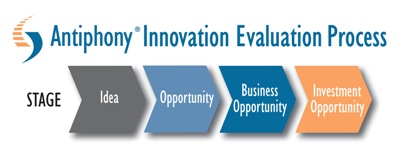You wouldn’t be where you are today if you weren’t innovative. You had the good idea and the wherewithal to turn that idea into a marketable product or service that now fuels your company. But are you sustaining and developing a pipeline of new, viable ideas? A focused innovation methodology will keep the pump primed and enable you to create the market space, differentiation, and profit you seek.
Antiphony Managing Director Rob Weber encourages you to rethink innovation in your own organization as a means to drive sustainable value and continued growth. For a copy of our soon-to-be published white paper on Innovation, please contact us at insights@antiphony.com.
Innovation: The Greatest Differentiator
 Rob Weber, Managing Director for Antiphony Partners, LLC, has held a variety of executive positions for emerging technology companies. Most recently, he was President of knoa, an e-learning software company. Prior to that, he was President of Elastomeric Technologies. Rob is a founder of Robin Hood Ventures and the Mid-Atlantic Angel Group (MAG) fund, angel investment groups focused on emerging growth companies. He lectures on innovation and technology at The Wharton School. Rob graduated from the Fisher Program in Management and Technology at the University of Pennsylvania where he earned Bachelor’s degrees in Economics and Applied Science degrees from The Wharton School and School of Engineering.
Rob Weber, Managing Director for Antiphony Partners, LLC, has held a variety of executive positions for emerging technology companies. Most recently, he was President of knoa, an e-learning software company. Prior to that, he was President of Elastomeric Technologies. Rob is a founder of Robin Hood Ventures and the Mid-Atlantic Angel Group (MAG) fund, angel investment groups focused on emerging growth companies. He lectures on innovation and technology at The Wharton School. Rob graduated from the Fisher Program in Management and Technology at the University of Pennsylvania where he earned Bachelor’s degrees in Economics and Applied Science degrees from The Wharton School and School of Engineering.
When it comes to innovation, most companies rely on a “eureka” approach, hoping good ideas will simply materialize when they need them. But those who establish and manage an innovation process — through which viable ideas are continuously generated, grown, and harvested – will reap enumerable benefits.
Establishing an ongoing Innovation process in your own organization will improve your ability to generate new, legitimate concepts and determine which merit further investment. Creating such a process takes commitment, ongoing management, and a willingness to take risks and spend money on the ideas that have real potential.
The Innovation Process has four stages that should be in continuous use to create a portfolio of ideas in various phases of exploration.

Idea
In Stage 1, the goal is to develop a large list of creative concepts for new products, services, processes, and strategies. Brainstorming sessions facilitated by experienced third parties are essential. The sessions should involve participants from across the organization representing all phases of creative, design, service, development, new business development, etc. They might even include customers and suppliers.
Opportunity
Ad hoc Concept Development Teams are formed in State 2 to create visual representations or even prototypes of the proposed product that can be demonstrated to target customers.
Business Opportunity
In this stage, marketplace interest in the concept is evaluated, as is the company’s ability to effectively produce and deliver the product or service. Business Development Teams (BDTs) follow the work of the Concept Development Teams to assess market opportunity. The BDTs create a full business plan and conduct market research.
Investment Opportunity
After advancing through Stages 1 to 3, concepts with the greatest promise move to Stage 4: investment opportunity analysis. Ultimately, senior leadership determines which concepts will be funded.
When innovation is cultivated strategically — with a defined process that encourages and nurtures new ideas to support top-line growth – it can become your greatest differentiator and competitive advantage.
To learn more about ways to implement an innovation process in your organization, please contact us at insights@antiphony.com.
How Best to Embrace Globalization
Jeffrey Babin, Antiphony
jbabin@antiphony.com
Our clients are increasingly focusing on developing global strategies. We believe that every company needs to embrace global business practices; however, most are appropriately concerned about the potential hazards.
Recently, I presented at a Global Summit at which one of my colleagues, Tom Kosnik of Stanford University, presented a number of compelling concepts in globalization strategies. Most people are familiar with Geoffrey Moore’s landmark work, Crossing the Chasm. Kosnik presents an interesting expansion of the Chasm concepts for globalization.
The traditional product lifecycle (Rogers, 1995) discusses the importance of segmenting the market to better evaluate those that tend to embrace innovative technologies early in the lifecycle versus those that seek more robust development of the product, markets, channels, and support services before adopting.
When considering globalization, Kosnik suggests, companies face the challenge of a double chasm. The first is the Market Chasm, based on the early majority adopter’s perceptions of the innovation’s technological risk. The second, and less well-known, is the Social Capital Chasm.
Companies seeking to expand globally may be confronted by their leadership’s lack of experience in each new country’s culture. In addition, these companies must grapple with the lack of trust in the companies’ and their leadership often felt by adopters in other countries.
Successful globalization requires leaders to consider both chasms and how best to address the strategic and tactical challenges raised by each.
To learn more about ways to embrace globalization in your organization, please contact us atinsights@antiphony.com.
Recommended Reading
 Making Innovation Work: How to Manage it, Measure It, and Profit From It
Making Innovation Work: How to Manage it, Measure It, and Profit From It
Tony Davila, Marc Epstein, and Robert Shelton (ISBN: 0131497863)
Authors Tony Davila, Marc Epstein, and Robert Shelton say that to compete effectively, you must innovate consistently across all products, services, and business functions. In this book, they share their techniques and strategies for managing innovation more effectively.
